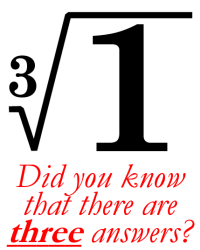Tag Archives: complex numbers
 Thinking back on your math classes, you may recall that the square root of a number has two answers, one positive and one negative. For example, the square root of +9 is both +3 and -3 (the first one is known as the principal square root). Squaring +3 gives you +9, of course, but so does squaring -3.
Thinking back on your math classes, you may recall that the square root of a number has two answers, one positive and one negative. For example, the square root of +9 is both +3 and -3 (the first one is known as the principal square root). Squaring +3 gives you +9, of course, but so does squaring -3.
Square roots aren’t the only roots of a number. For example, the (principal) cube root of +8 is +2 because +2³ = +2 × +2 × +2 = +8.
But just as square roots have two answers, cube roots have three (and fourth roots have four and so on and so on).
Continue reading
3 Comments | tags: complex numbers, complex plane, cube roots, Euler's Formula | posted in Brain Bubble, Math
 I’ve written a number of posts about four-dimensional Euclidean space, usually in the context of one of my favorite geometrical objects, the tesseract. I’ve also mentioned 4D Euclidean spaces as just one of many possible multi-dimensional parameter spaces. In both cases, the familiar 2D and 3D spaces generalize to additional dimensions.
I’ve written a number of posts about four-dimensional Euclidean space, usually in the context of one of my favorite geometrical objects, the tesseract. I’ve also mentioned 4D Euclidean spaces as just one of many possible multi-dimensional parameter spaces. In both cases, the familiar 2D and 3D spaces generalize to additional dimensions.
This post explores a specialized 4D space that uses complex numbers along each axis of a 2D nominally Euclidean space. Each X & Y coordinate has two degrees of freedom, a magnitude and a phase. This doesn’t make 4D spaces easier to visualize, but it can offer a useful way to think about them.
It also connects back to something I wrote about in my QM-101 series.
Continue reading
11 Comments | tags: 4D, complex numbers, complex plane | posted in Math, Sideband
 Last time I opened with basic exponentiation and raised it to the idea of complex exponents (which may, or may not, have been surprising to you). I also began exploring the ubiquitous exp function, which enables the complex math needed to deal with such exponents.
Last time I opened with basic exponentiation and raised it to the idea of complex exponents (which may, or may not, have been surprising to you). I also began exploring the ubiquitous exp function, which enables the complex math needed to deal with such exponents.
The exp(x) function, which is the same as ex, appears widely throughout physics. The complex version, exp(ix), is especially common in wave-based physics (such as optics, sound, and quantum mechanics). It’s instrumental in the Fourier transform.
Which in turn is as instrumental to mathematicians and physicists as a hammer is to carpenters and pianos.
Continue reading
8 Comments | tags: complex numbers, complex plane, exponential function, exponentiation, Fourier transform, Heisenberg Uncertainty | posted in Math, Physics
 Five years ago today I posted, Beautiful Math, which is about Euler’s Identity. In the first part of that post I explored why the Identity is so exquisitely beautiful (to mathematicians, anyway). In the second part, I showed that the Identity is a special case of Euler’s Formula, which relates trigonometry to the complex plane.
Five years ago today I posted, Beautiful Math, which is about Euler’s Identity. In the first part of that post I explored why the Identity is so exquisitely beautiful (to mathematicians, anyway). In the second part, I showed that the Identity is a special case of Euler’s Formula, which relates trigonometry to the complex plane.
Since then I’ve learned how naïve that post was! It wasn’t wrong, but the relationship expressed in Euler’s Formula is fundamental and ubiquitous in science and engineering. It’s particularly important in quantum physics with regard to the infamous Schrödinger equation, but it shows up in many wave-based contexts.
It all hinges on the complex unit circle and the exp(i×π×a) function.
Continue reading
13 Comments | tags: 3Blue1Brown, complex numbers, complex plane, Euler's Formula, Euler's Identity, exponential function, Fourier transform | posted in Math

Multiplying by i…
Recently I did a series of posts about how the complex numbers arise from a natural progression of math realizations. I’ve done posts in the past about how the natural numbers lead through the integers and rationals to the real numbers. (And I’ve done posts about how weird the real numbers are, but that’s another topic.)
I recently came across another way a progression of obvious natural questions directly leads to the necessity of a new type of number, and this progression takes us all the way from the naturals to the complex numbers.
All by asking, “What do you get when you…”
Continue reading
7 Comments | tags: complex numbers, complex plane, group theory, groups, integers, irrational numbers, natural numbers, rational numbers, real numbers, sets, town barber paradox | posted in Math
 In recent posts I’ve presented the complex numbers and the complex plane. Those were just stepping stones to this post, which involves a basic fact about the Mandelbrot set. It’s something that I stumbled over recently (after tiptoeing around it many times, because math).
In recent posts I’ve presented the complex numbers and the complex plane. Those were just stepping stones to this post, which involves a basic fact about the Mandelbrot set. It’s something that I stumbled over recently (after tiptoeing around it many times, because math).
This is one of those places where something that seems complicated turns out to have a fairly simple (and kinda cool) way to see it when approached the right way. In this case, it’s the way multiplication rotates points on the complex plane. This allows us to actually visualize certain equations.
With that, we’re ready to move on to the “heart” of the matter…
Continue reading
20 Comments | tags: cartioid, complex numbers, fun with numbers, Mandelbrot, Mandelbrot fractal, real numbers | posted in Math
 In the first post I explained why the mathematical “imaginary” number i is “real” (in more than one sense of the word). That weird number is just a stepping stone to the complex numbers, which are themselves stepping stones to the complex plane.
In the first post I explained why the mathematical “imaginary” number i is “real” (in more than one sense of the word). That weird number is just a stepping stone to the complex numbers, which are themselves stepping stones to the complex plane.
Which, in turn, is a big stepping stone to a fun fact about the Mandelbrot I want to write about. (But we all have to get there, first.) I think it’s a worthwhile journey — understanding the complex plane opens the door to more than just the Mandelbrot. (For instance, Euler’s beautiful “sonnet” also lives on the complex plane.)
As it turns out, the complex numbers cause this plane to “fly” a little bit differently than the regular X-Y plane does.
Continue reading
7 Comments | tags: complex numbers, complex plane, imaginary unit, numbers, real numbers | posted in Math

Graph of ax2 for diff a values.
(green < 1; blue = 1; red > 1)
This is a little detour before the main event. The first post of this series, which explained why the imaginary unit, i, is important to math, was long enough; I didn’t want to make it longer. However, there is a simple visual way of illustrating exactly why it seems, at least initially, that the original premise isn’t right.
There is also a visual way to illustrate the solution, but it requires four dimensions to display. Three dimensions can get us there if we use some creative color shading, but we’re still stuck displaying it on a two-dimensional screen, so it’ll take a little imagination on our part.
And while the solution might not be super obvious, the problem sure is.
Continue reading
9 Comments | tags: complex numbers, fun with numbers, imaginary unit, numbers, parabola, real numbers, x-squared | posted in Math
 Yes, this is a math post, but don’t run off too quickly. I’ll keep it as simple as possible (but no simpler), and I’ll do all the actual math so you can just ride along and watch. What I’m about here is laying the groundwork to explain a fun fact about the Mandelbrot.
Yes, this is a math post, but don’t run off too quickly. I’ll keep it as simple as possible (but no simpler), and I’ll do all the actual math so you can just ride along and watch. What I’m about here is laying the groundwork to explain a fun fact about the Mandelbrot.
This post is kind of an origin story. It seeks to explain why something rather mind-bending — the so-called “imaginary numbers” — are actually vital members of the mathematical family despite being based on what seems an impossibility.
The truth is math would be a bit stuck without them.
Continue reading
21 Comments | tags: complex numbers, complex plane, fun with numbers, imaginary unit, integers, Leopold Kronecker, natural numbers, numbers, rational numbers, real numbers | posted in Math
 In the Rational vs Real post I mentioned that real numbers were each “an infinitely tiny island separated from direct contact with all other numbers.” The metaphor of each real number as an island comes from how, given any real number, it’s not possible to name the next (or previous) real number.
In the Rational vs Real post I mentioned that real numbers were each “an infinitely tiny island separated from direct contact with all other numbers.” The metaphor of each real number as an island comes from how, given any real number, it’s not possible to name the next (or previous) real number.
It’s easy enough to name a particular real number. For instance 1.0 and 3.14159… real numbers. There are infinitely many more we can name, but given any one of them, there is no way to get to any other number other than by explicitly naming it, too.
This applies to a variety of numeric spaces.
Continue reading
9 Comments | tags: complex numbers, continuum, integers, math theory, mathematics, natural numbers, numbers, rational numbers, real numbers, Theory of Mathematics | posted in Math
 Thinking back on your math classes, you may recall that the square root of a number has two answers, one positive and one negative. For example, the square root of +9 is both +3 and -3 (the first one is known as the principal square root). Squaring +3 gives you +9, of course, but so does squaring -3.
Thinking back on your math classes, you may recall that the square root of a number has two answers, one positive and one negative. For example, the square root of +9 is both +3 and -3 (the first one is known as the principal square root). Squaring +3 gives you +9, of course, but so does squaring -3. I’ve written
I’ve written 

 In recent posts I’ve presented
In recent posts I’ve presented 

 Yes, this is a math post, but don’t run off too quickly. I’ll keep it as simple as possible (but no simpler), and I’ll do all the actual math so you can just ride along and watch. What I’m about here is laying the groundwork to explain a fun fact about the
Yes, this is a math post, but don’t run off too quickly. I’ll keep it as simple as possible (but no simpler), and I’ll do all the actual math so you can just ride along and watch. What I’m about here is laying the groundwork to explain a fun fact about the 












